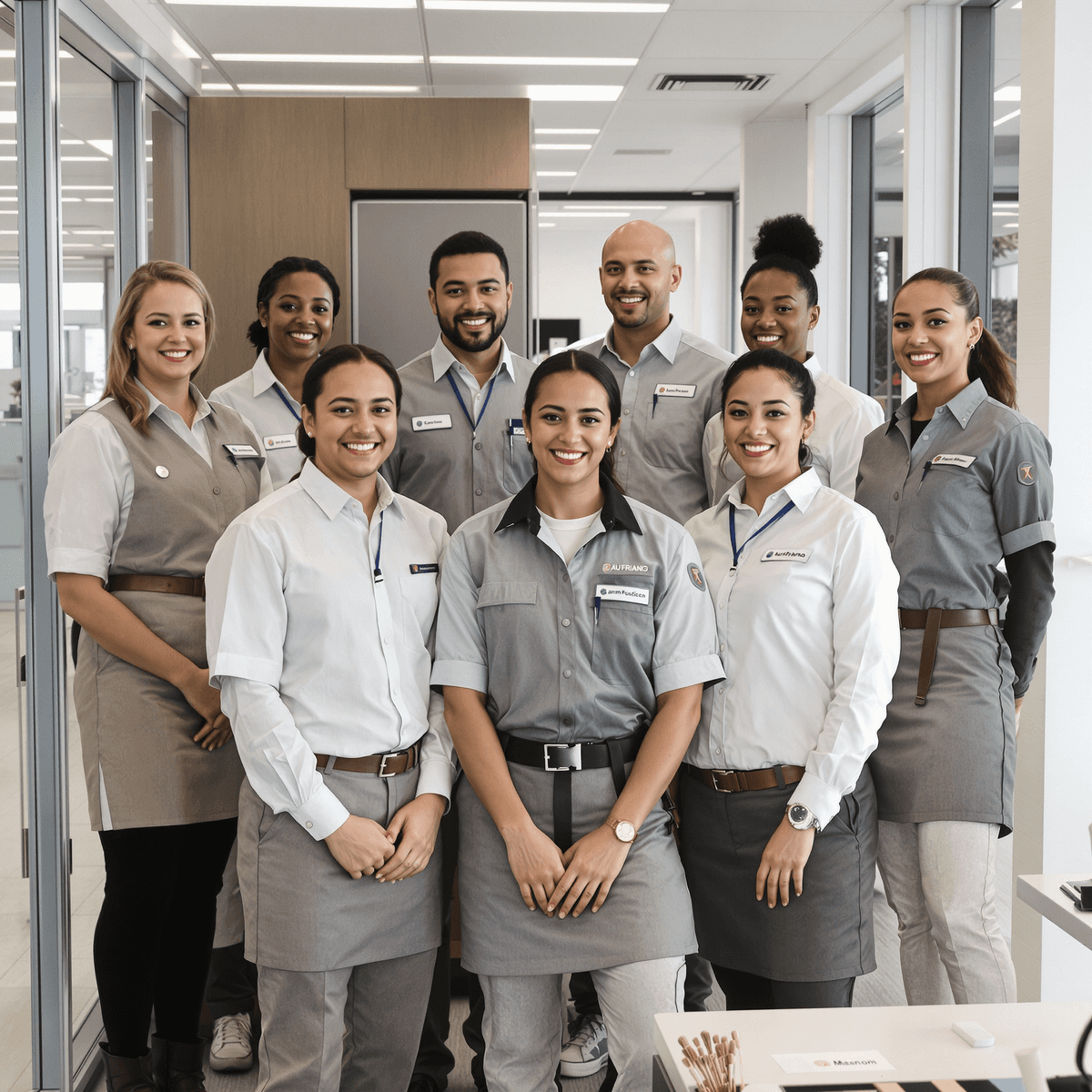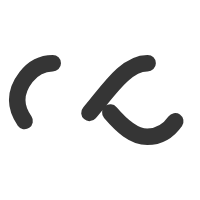
Uniforms play a significant role in shaping workplace culture, going beyond their practical purpose. These standardise outfits are powerful psychological tools that influence team dynamics, employee behaviour, and organizational success.
Research shows that what you wear at work impacts your mindset, performance, and interactions with colleagues. A well-designed uniform policy can:
- Create a strong sense of belonging
- Reduce workplace stress around clothing choices
- Level social hierarchies
- Boost team confidence
The psychological impact of workplace attire is profound – from the colors that affect mood to the branded elements that reinforce company values. By understanding these psychological principles, you can use uniforms strategically to build stronger teams and drive productivity.
Your workplace uniform is more than just clothing – it’s a strategic tool for shaping organisation culture and enhancing the employee experience.
The Role of Uniforms in Shaping Team Identity and Unity
Uniforms are more than just clothing; they are a powerful symbol of team identity. When employees wear matching outfits, they become part of a cohesive group with common goals and values. This visual representation of the organisation mission and culture is further reinforced by research findings.
Research Findings on the Impact of Uniforms
According to studies, uniforms have a positive impact on employees in various ways:
- Enhanced team recognition: 78% of employees feel more connected to their colleagues when wearing uniforms.
- Stronger brand association: 82% of employees demonstrate increased awareness of company values through uniform attire.
- Improved collaboration: 65% of employees note better teamwork in environments where uniforms are worn.
Breaking Down Barriers with Uniforms
The psychological effect of wearing uniforms goes beyond appearances. Uniforms eliminate visual hierarchies and social barriers, creating an inclusive environment where every team member feels valued. This sense of equality fosters genuine connections among colleagues, regardless of their position or background.
Learning from Sports Teams
We can learn from sports teams when it comes to building unity through uniforms. Just like athletes wear jerseys to signify their allegiance to a particular team, professionals can also use work uniforms as a way to communicate their commitment towards collective success.
Benefits of Wearing Work Uniforms
Here are some benefits that come with putting on your work uniform:
- Signalling readiness: Wearing a uniform indicates that you are prepared to contribute towards achieving organisational goals.
- Establishing team culture: Uniforms help create a distinct culture within teams by promoting shared values and behaviour.
- Defining roles: Different job functions may require specific attire which helps clarify individual responsibilities.
- Maintaining professionalism: Uniforms set boundaries between work and personal life, ensuring employees present themselves appropriately at all times.
- Fostering pride: When individuals take pride in their appearance, it reflects positively on the entire organisation.
The Power of Visual Identity
The act of wearing a uniform triggers psychological changes in employees – it prepares them mentally to embrace their professional roles and embody organisation values. This transformation strengthens bonds among team members while projecting a unified image during customer interactions.
In conclusion, uniforms play an essential role in shaping team identity and fostering unity within organisation. By understanding the impact they have on individuals’ perceptions and relationships, businesses can leverage this knowledge to create more cohesive teams that work together towards common objectives.
The Psychological Impact of Design Elements in Workplace Uniforms
The Power of Color Choices
Color choices in workplace uniforms create powerful psychological effects that influence employee performance and mindset. Research shows specific colors trigger distinct emotional responses:
- Blue uniforms inspire trust and promote calm decision-making
- Red attire increases energy levels and creates urgency
- Black conveys authority and professional competence
- Green reduces stress and enhances creative thinking
Shaping Behaviour through Branding
The strategic placement of branding elements on uniforms shapes employee behaviour and organisation identity. A prominently displayed company logo on the chest area serves as a constant reminder of corporate values and responsibility. This visual cue encourages employees to embody brand attributes in their daily interactions.
Perception of Roles through Design
Uniform design elements affect how employees perceive their roles. Healthcare workers wearing crisp white uniforms report heightened awareness of hygiene protocols. Restaurant staff in branded aprons demonstrate increased attention to customer service standards.
Customer Perception and Satisfaction
The psychological impact extends to customer perception. A study by the Journal of Marketing Research found that employees wearing branded uniforms with thoughtful design elements received 23% higher customer satisfaction ratings.
Considering Responses in Uniform Design
Smart uniform design considers both conscious and subconscious responses:
- Size and placement of logos impact confidence levels
- Color combinations influence energy and focus
- Material textures affect comfort and performance
- Design consistency reinforces team cohesion
Balancing Individuality and Uniformity: The Case for Customisation in Work Attire
Personalization options in workplace uniforms create a dynamic balance between professional consistency and personal identity. Companies can implement several customisation strategies while maintaining brand standards:
Flexible Uniform Elements
- Offering multiple approved shirt styles
- Allowing choice in accessories
- Providing seasonal variations
- Incorporating adjustable features
The benefits of customisation uniforms extend beyond employee satisfaction:
- Increased ownership of company representation
- Higher compliance with dress codes
- Enhanced comfort leading to improved performance
- Stronger personal connection to the brand
Smart Customisation Guidelines
- Set clear boundaries for acceptable modifications
- Create a range of pre-approved options
- Define specific areas for personal expression
- Establish visual consistency requirements
Companies like Starbucks demonstrate successful uniform customisation by allowing employees to express themselves through hair colour, jewellery, and clothing variations while maintaining core brand elements. Southwest Airlines permits flight attendants to choose from multiple uniform combinations, fostering individuality within professional parameters.
Challenges in implementing customisation uniforms include:
- Maintaining visual cohesion across teams
- Managing procurement costs
- Ensuring equitable access to options
- Preserving brand recognition
The key lies in creating structured flexibility – providing enough options for personal expression while preserving the unified team appearance that uniforms are designed to achieve.
Practical Considerations Beyond Psychology: Functional Aspects of Workplace Uniforms in Different Industries
Different industries have specific uniform requirements that go beyond psychological benefits. Here’s how uniforms serve practical purposes across sectors:
Healthcare Settings
- Antimicrobial fabrics prevent cross-contamination
- Color-coded scrubs identify different departments
- Quick-dry materials maintain hygiene standards
Construction Sites
- High-visibility elements ensure worker safety
- Reinforced materials protect against workplace hazards
- Weather-resistant fabrics adapt to outdoor conditions
Service Industry
- Stain-resistant materials for food service workers
- Breathable fabrics for active movement
- Durable materials withstand frequent washing
The right uniform design takes into account these specific needs of each industry while also prioritising comfort. By using smart fabric choices and thoughtful design elements, uniforms can be created that not only protect workers and meet safety regulations but also allow for optimal performance. When selecting uniforms, it is important to consider these practical requirements alongside any aesthetic considerations.
Addressing Concerns and Resistance: Effective Strategies for Implementing Uniform Policies That Foster Team Morale Without Compromising Individuality or Comfort Levels Among Employees
Employee resistance to uniform policies often stems from genuine worries about personal expression and comfort. Some common objections include:
- Limited self-expression through clothing choices
- Physical discomfort from ill-fitting garments
- Cultural or religious dress requirements
- Cost implications for maintenance
Successful implementation requires a collaborative approach. You can reduce resistance by employing strategies similar to those outlined in the Promising Practices for Meaningful Public Involvement in Transportation Decision-making. These strategies include:
- Employee surveys to gather feedback on design preferences
- Focus groups to test uniform prototypes
- Flexible options within the uniform policy
- Clear communication about the reasons behind uniform decisions
Creating a uniform committee with representatives from different departments helps build trust and ownership in the process. This inclusive approach allows employees to voice concerns while maintaining the benefits of a cohesive dress code.
Consider offering customization options like:
- Choice of sleeve length
- Multiple fabric options
- Adjustable fit preferences
- Personalised name badges or pins
These adaptations show respect for individual needs while still projecting the professional image your organisation wants to maintain. It’s also important to remember that uniform guidelines should be reviewed regularly to ensure they meet the evolving needs of employees and the organisation. Additionally, leveraging data and research, such as that found in this GAO report, can provide valuable insights into best practices for implementing uniform policies effectively.
Future-Proofing Workplace Attire: Embracing Innovation, Sustainability, And Inclusive In Uniform Design For A Diverse And Evolving Workforce
Workplace uniforms are evolving to meet the needs of a diverse and changing workforce. Here are some key areas where innovation, sustainability, and exclusivity are being embraced in uniform design:
1. Innovation through Smart Textiles
Smart textiles are transforming workplace uniforms by incorporating cutting-edge features that enhance functionality and comfort. Some examples include:
- Temperature-regulating fabrics that adapt to environmental changes
- UV-protective materials for outdoor workers
- Anti-microbial properties for healthcare settings
- Self-cleaning nanotechnology reducing maintenance costs
2. Sustainability in Uniform Design
Sustainable practices are becoming increasingly important in uniform design. Brands are prioritizing eco-friendly materials and production methods to minimize their environmental impact. This includes:
- Using recycled materials and sustainable production processes
- Designing uniforms for durability to reduce the need for frequent replacements
- Exploring biodegradable options for end-of-life disposal
3. Inclusivity in Modern Workplace Uniforms
Modern workplace uniforms are embracing diversity by catering to a wide range of body types, genders, and cultural requirements. This is achieved through:
- Offering size-inclusive ranges from XS to 4XL
- Incorporating gender-neutral design options
- Creating adaptable pieces that accommodate religious and cultural needs
- Implementing adjustable features for pregnancy and physical disabilities
These advancements go beyond meeting practical needs; they also promote psychological comfort and a sense of belonging among employees in increasingly diverse workplaces. By prioritizing innovation, sustainability, and inclusivity in uniform design, brands can create attire that not only looks professional but also reflects the values of their workforce.
Conclusion
The Psychology of Uniforms goes beyond just the fabric and design choices – it’s a strategic investment in employee well-being and workplace dynamics. Strategic uniform policies create a delicate balance between team cohesion and individual expression, directly impacting how employees perceive themselves and their roles within the organization.
A well-designed uniform program delivers multiple benefits:
- Strengthens team identity while respecting personal uniqueness
- Creates psychological safety through shared visual identity
- Builds confidence and professional presence
- Reduces decision fatigue and workplace attire stress
- Promotes equality and inclusivity across all organizational levels
The success of workplace uniforms lies in thoughtful implementation that considers both practical functionality and psychological impact. Organizations that view uniforms as tools for positive cultural transformation – rather than mere dress codes – unlock their true potential for enhancing workplace dynamics.
Your uniform policy shapes daily experiences, team interactions, and brand representation. When you prioritize employee comfort, personal expression, and practical needs alongside organizational goals, uniforms become powerful catalysts for creating positive workplace cultures where every team member feels valued and empowered to contribute their best work.
FAQs (Frequently Asked Questions)
Why are uniforms important in the workplace for team dynamics?
Uniforms act as a visual manifestation of a team’s identity and values, fostering a sense of belonging and promoting unity among employees. Understanding the psychological impact of workplace attire can enhance team morale and overall productivity.
How do design elements like color and branding affect employee psychology?
Colors in uniforms influence employee mood, behavior, and perception of their role within the organization. Incorporating branding elements such as logos and slogans reinforces brand identity while positively impacting team cohesion and individual motivation.
Can employees personalize their uniforms without compromising team unity?
Balancing individuality and uniformity is achievable by allowing customization within set guidelines. This approach supports personal expression while maintaining a cohesive brand representation, benefiting both employee satisfaction and organizational image.
What practical factors should be considered when designing workplace uniforms across industries?
Industry-specific requirements such as healthcare hygiene, construction safety, and service professionalism must be prioritized to ensure uniforms support employee well-being and functional needs alongside psychological benefits.
How can organizations address employee resistance to uniform policies?
Common concerns include infringement on individuality and discomfort. Effective strategies involve proactive communication, involving employees in decision-making, and ensuring comfort to foster acceptance while maintaining team morale.
What trends are shaping the future of workplace uniform design?
Innovation in smart textiles offering enhanced functionality like moisture-wicking, sustainability initiatives, and inclusivity considerations for diverse body types, cultural backgrounds, and gender identities are key factors in future-proofing workplace attire.
Powered by junia.ai. To remove branding, please upgrade to a paid plan.

